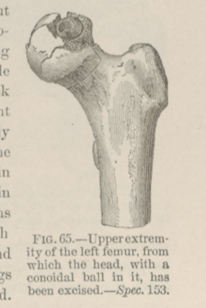Title: Sennett, Henry C.
Source text: The Medical and Surgical History of the War of the Rebellion. (1861-65.), Part 3, Volume 2 (Washington, DC: Government Printing Office, 1883), 109-110.
Civil War Washington ID: med.d2e5856
TEI/XML: med.d2e5856.xml
CASE 257.—Corporal Henry C. Sennett, Co. F, 122d New York, aged 27 years, was wounded in front of Petersburg, March 27, 1865, by a conoidal musket ball, which entered midway between the anterior superior spinous process of the ilium and the trochanter major, and lodged in the head of the left femur. The patient was removed to Washington, and, on April 2d, was admitted to Mount Pleasant Hospital. He was feverish and fretful, and his tongue was furred; but the wound had a healthy aspect, and there was but little swelling or deformity of the limb. But exploration with the finger proved that the ball had penetrated the hip joint. On April 4th the patient being anæsthetized by an equal mixture of chloroform arid ether, Assistant Surgeon H. Allen, U. S. A., made a T-shaped incision, four inches by six inches, over the trochanter major, and excised the head and neck of the femur. The head was fractured into three pieces, and the ball was embedded in it. Violent hiccough came on immediately after the operation and continued through the night, but was finally arrested by the persistent use of antispasmodics. On April 5th and 6th there was great tympanitis, the bowels being obstinately constipated. An enema of castor oil was administered without effect, and in two hours another of molasses and water and salt, which induced a slight evacuation. Singultus again recurred. On April 7th the bowels moved freely. A chill occurred, lasting half an hour. There was great abdominal tenderness on pressure, and other well marked symptoms of peritonitis. On the 8th the hiccough continued; the abdomen became greatly distended; the countenance became pinched and ghastly, and the patient died at ten at night. At the autopsy, made twelve hours after death, the lungs were found healthy; the liver greatly hypertrophied; the lower fifth of the ilium inflamed and injected. The tissues surrounding the hip joint were in a sloughing condition, and were infiltrated with fetid pus, which had burrowed several inches under the gluteal muscles and two inches below the trochanter minor. The acetabulum was denuded and slightly fractured at its upper and posterior border. Two inches of the upper extremity of the shaft of the femur was denuded of periosteum. The specimen was presented by Dr. Allen to the Army Medical Museum, and is represented in the adjoining wood-cut (FIG. 65). The innominate bone was not removed; but the upper fourth of the femur was sawn off after death, and mounted with the excised head to show how completely the injury to the femur was limited to the epiphysis. Had it not been for the fracture of the pelvis, it would have been difficult to have found a case better adapted for the operation of primary excision.
